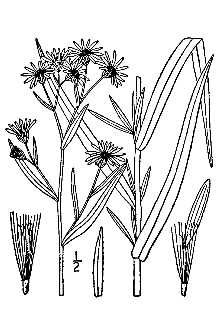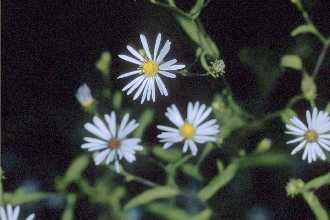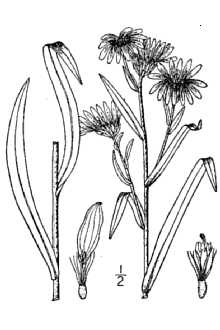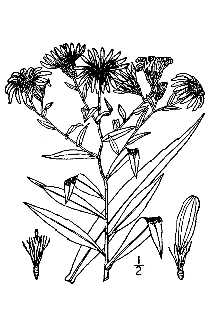Symphyotrichum longifolium (Lam.) G.L. Nesom, as to type
Scientific Name: Symphyotrichum longifolium (Lam.) G.L. Nesom, as to type

| General Information | |
|---|---|
| Usda Symbol | SYLO3 |
| Group | Dicot |
| Life Cycle | Perennial |
| Growth Habits | Forb/herb |
| Native Locations | SYLO3 |
Plant Guide
Alternative Name
Michaelmas daisy, Aster novi-belgii
Uses
Landscape: New York aster is an excellent upright perennial for a mixed bed or border, This species provides a color accent, bringing autumn color to the garden, Wildlife: New York aster is known for attracting butterflies and moths to areas where it is found growing, Use soil moisture sensors to measure the soil moisture of Symphyotrichum longifolium (Lam.) G.L. Nesom, as to type., This is a good bee plant providing nectar in the autumn, Most species in this genus seem to be immune to the predictions of rabbits (Thomas 1990),
Status
Please consult the Plants Web site and your State Department of Natural Resources for this plant’s current status, such as, state noxious status, and wetland indicator values.
Description
General: Aster family (Asteraceae). New York aster is an upright, native perennial that grows between one and a half to five feet tall. The leaves are elliptic to linear, smooth to scabrous above and glabrous beneath (Radford, Ahles & Bell 1968). The disc flowers are red to yellow. The flowers are hermaphrodite (having both male and female organs) and are pollinated by bees, butterflies, flies, beetles and moths. Distribution: New York aster ranges from Newfoundland and Nova Scotia south to Georgia, apparently to Alabama, chiefly near the coast (Tiner 1987). For current distribution, please consult the Plant profile page for this species on the PLANTS Web site. © Don Kurz @ PLANTS
Adaptation
New York aster is found growing in slightly brackish and tidal fresh marshes, occasionally borders of salt marshes; inland marshes, shrub marshes, shores and other moist areas (Tiner 1987). This plant requires well-drained soil and prefers sandy, loamy and clay soils. It can grow on nutritionally poor soil, in semi-shade or no shade but prefers a sunny location.
Establishment
Propagation by Seed: New York aster seeds should be sown fresh in the fall or spring (Heuser 1997). Pre-chill spring sown seeds to improve germination. When the seedlings are large enough to handle, place them into individual pots and plant them out in the summer. Division of this species should be done in the spring. Large divisions can be planted into their permanent positions whereas smaller clumps should be kept in a cold frame until they are growing well.
Management
Divisions of New York aster should be done in the spring every three years to maintain vigor (Heuser 1997). Regular spraying is recommended for this species because it is prone to mildew and attack from pests. Cultivars, Improved and Selected Materials (and area of origin) Available through some native plant seed sources. Contact your local Natural Resources
Conservation
Service (formerly Soil Conservation Service) office for more information. Look in the phone book under ”United States Government.” The Natural Resources Conservation Service will be listed under the subheading “Department of Agriculture.”
References
Gleason, H.A. & A. Cronquist 1991. Manual of the vascular plants of northeastern United States and adjacent Canada. 2nd ed. The New York Botanical Garden, Bronx, New York. Heuser, C.W. 1997. The complete book of plant propagation. The Taunton Press, Newtown, Connecticut. Huxley, A. 1992. The new RHS dictionary of gardening. MacMillan Press, New York, New York. Radford, A.E., H.E. Ahles, & C. Bell 1968. Manual of the vascular flora of the Carolinas. The University of North Carolina Press, Chapel Hill, North Carolina. Thomas, G.S. 1990. Perennial garden plants. J.M. Dent & Sons, London Tiner, R.W., Jr. 1987. A field guide to the coastal wetland plants of the northeastern United States. The University of Massachusetts Press, Amherst, Massachusetts.
Plant Traits
Growth Requirements
| Temperature, Minimum (°F) | -33 |
|---|---|
| Adapted to Coarse Textured Soils | No |
| Adapted to Fine Textured Soils | Yes |
| Adapted to Medium Textured Soils | Yes |
| Anaerobic Tolerance | Medium |
| CaCO3 Tolerance | Low |
| Cold Stratification Required | No |
| Drought Tolerance | Low |
| Fertility Requirement | Low |
| Fire Tolerance | High |
| Frost Free Days, Minimum | 180 |
| Hedge Tolerance | None |
| Moisture Use | High |
| pH, Maximum | 7.0 |
| pH, Minimum | 5.5 |
| Planting Density per Acre, Maxim | 11000 |
| Planting Density per Acre, Minim | 2700 |
| Precipitation, Maximum | 60 |
| Precipitation, Minimum | 40 |
| Root Depth, Minimum (inches) | 10 |
| Salinity Tolerance | None |
| Shade Tolerance | Intolerant |
Morphology/Physiology
| After Harvest Regrowth Rate | Moderate |
|---|---|
| Toxicity | None |
| Resprout Ability | No |
| Shape and Orientation | Erect |
| Active Growth Period | Spring, Summer, Fall |
| Bloat | None |
| C:N Ratio | Medium |
| Coppice Potential | No |
| Fall Conspicuous | Yes |
| Fire Resistant | No |
| Flower Color | Purple |
| Flower Conspicuous | Yes |
| Foliage Color | Green |
| Foliage Porosity Summer | Porous |
| Foliage Porosity Winter | Porous |
| Fruit/Seed Color | Brown |
| Nitrogen Fixation | None |
| Low Growing Grass | No |
| Lifespan | Short |
| Leaf Retention | No |
| Known Allelopath | No |
| Height, Mature (feet) | 6.0 |
| Growth Rate | Moderate |
| Growth Form | Rhizomatous |
| Fruit/Seed Conspicuous | No |
| Foliage Texture | Fine |
Reproduction
| Vegetative Spread Rate | Moderate |
|---|---|
| Small Grain | No |
| Seedling Vigor | Low |
| Seed Spread Rate | Slow |
| Fruit/Seed Period End | Fall |
| Seed per Pound | 700000 |
| Propagated by Tubers | No |
| Propagated by Sprigs | No |
| Propagated by Sod | No |
| Propagated by Seed | Yes |
| Propagated by Corm | No |
| Propagated by Container | Yes |
| Propagated by Bulb | No |
| Propagated by Bare Root | Yes |
| Fruit/Seed Persistence | Yes |
| Fruit/Seed Period Begin | Fall |
| Fruit/Seed Abundance | Medium |
| Commercial Availability | Routinely Available |
| Bloom Period | Summer |
| Propagated by Cuttings | Yes |
Suitability/Use
| Veneer Product | No |
|---|---|
| Pulpwood Product | No |
| Post Product | No |
| Palatable Human | No |
| Palatable Graze Animal | Low |
| Palatable Browse Animal | Low |
| Nursery Stock Product | No |
| Naval Store Product | No |
| Lumber Product | No |
| Fodder Product | No |
| Christmas Tree Product | No |
| Berry/Nut/Seed Product | No |




